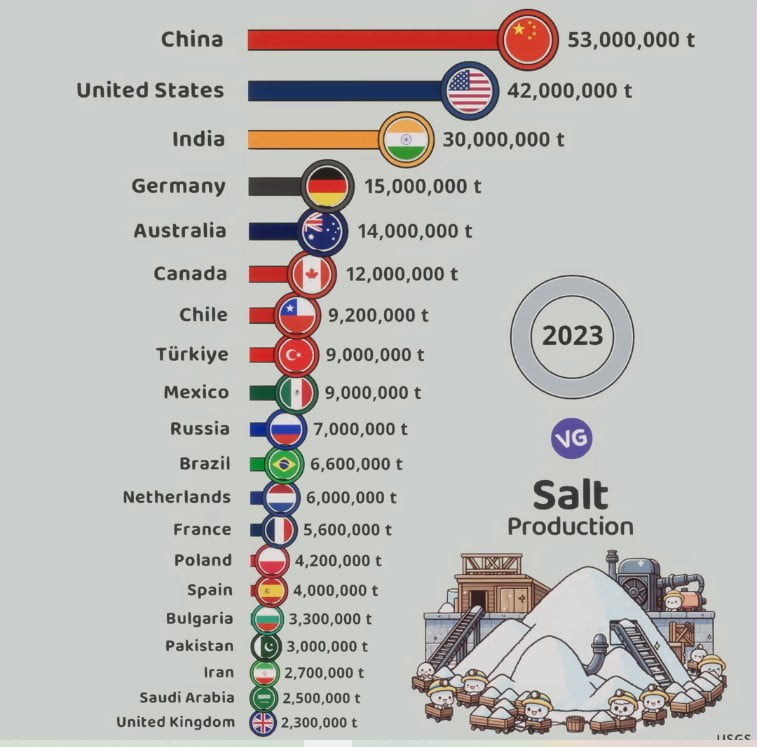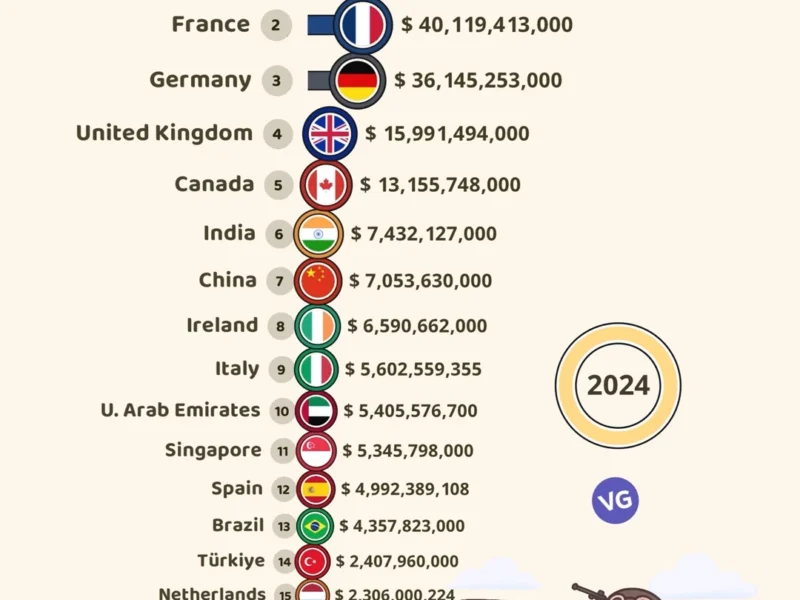China is the biggest salt producer globally, creating 64 million metric tons yearly.1 This makes up more than one-fifth of all the salt made worldwide, proving China’s leading position.2 The United States and India are next, producing about 42 million and 30 million tons each year.1 Altogether, these nations make almost half of the salt the world uses.2
Salt Production by Country in 2023
| Rank | Country | Salt Production (tonnes) |
|---|---|---|
| 1 | 🇨🇳 China | 53,000,000 |
| 2 | 🇺🇸 United States | 42,000,000 |
| 3 | 🇮🇳 India | 30,000,000 |
| 4 | 🇩🇪 Germany | 15,000,000 |
| 5 | 🇦🇺 Australia | 14,000,000 |
| 6 | 🇨🇦 Canada | 12,000,000 |
| 7 | 🇨🇱 Chile | 9,200,000 |
| 8 | 🇹🇷 Türkiye | 9,000,000 |
| 9 | 🇲🇽 Mexico | 9,000,000 |
| 10 | 🇷🇺 Russia | 7,000,000 |
| 11 | 🇧🇷 Brazil | 6,600,000 |
| 12 | 🇳🇱 Netherlands | 6,000,000 |
| 13 | 🇫🇷 France | 5,600,000 |
| 14 | 🇵🇱 Poland | 4,200,000 |
| 15 | 🇪🇸 Spain | 4,000,000 |
| 16 | 🇧🇬 Bulgaria | 3,300,000 |
| 17 | 🇵🇰 Pakistan | 3,000,000 |
| 18 | 🇮🇷 Iran | 2,700,000 |
| 19 | 🇸🇦 Saudi Arabia | 2,500,000 |
| 20 | 🇬🇧 United Kingdom | 2,300,000 |
Key Takeaways
- China is the world’s largest salt producer, generating around 64 million metric tons of salt annually.
- The United States and India are the second and third-largest salt producers, respectively, with the US producing around 42 million metric tons and India producing over 30 million metric tons.
- Collectively, China, the US, and India account for around 45% of the world’s total salt production.
- Other major salt producers include Germany, Canada, and Australia, each playing a significant role in the global salt industry.
- The top six salt-producing countries – China, the US, India, Germany, Canada, and Australia – account for more than half of the worldwide salt production.
Introduction to Global Salt Production
Salt is crucial in many fields like food, water treatment, and chemicals.2 What makes a country good at making salt? It’s about having salt deposits or access to the sea. The climate and skilled workers matter too.2 Places with these advantages make the most salt in the world. Learn More.
Importance of Salt in Various Industries
Salt has a big role in industries like food, water softening, and chemicals. In food, salt keeps food fresh, adds taste, and helps in preparing food. Water treatment uses it to clean and soften water. The chemical industry uses salt to make many products like chlorine and acids.
Key Factors Influencing Salt Production
The presence of natural salt deposits is key for salt production globally.2 Countries like China, the U.S, and India benefit a lot because they have large salt reserves.2 Being near the sea and having dry weather helps make salt through solar evaporation too.3 Skilled workers and good infrastructure also boost a country’s ability to produce salt.
China: The World’s Leading Salt Producer
Salt Production by Country (2023)
Source: Image data (2023)
China leads the world in salt production, making about 64 million metric tons every year.4 Major production areas include Inner Mongolia and Ningxia. These places have vast salt flats.2 In 2012, China made 62,158,000 metric tonnes of salt. This was 22.48% of all salt produced globally, says the British Geological Survey (BGS).2 According to the United States Geological Survey (USGS), China made 70,000,000 metric tonnes in the same year. This was 27.03% of the world’s total.2
Major Salt Producing Regions in China
In China, salt comes mainly from Inner Mongolia and Ningxia. These places have the right climate and plenty of salt. This helps them be major salt producers in the world.
Salt Production Techniques in China
China meets its high salt needs using several methods. These include solar evaporation, getting salt from brine, and mining rock salt. The country has advanced ways to get salt from different sources. This keeps China at the top of salt production worldwide.
The United States: A Powerhouse in Salt Production
The United States is second only to China in salt production.5 It creates about 42 million tons of salt each year. This large amount comes from the country’s many salt mines and production plants.
Top Salt Producing States in the US
States like Ohio, Texas, Utah, and others are big players in salt production.5 They are rich in salt and use the latest technology to extract it. This helps meet the increasing demand for salt all over the world.
Ohio leads in mining rock salt, thanks to the salt in its Appalachian Basin.5 Meanwhile, Texas uses solar evaporation near its coast to harvest sea salt.5 And Utah benefits from the Great Salt Lake, a key source of salt in the world.
Countries like Kansas, Michigan, Louisiana, and New York also play a big role in America’s salt production.5 Each has its own special conditions for salt making. This includes unique land formations and weather that make salt production easier and cheaper.
The U.S.’s broad salt production areas show its global importance in the salt trade.5 It supplies salt to various industries worldwide, from food to chemical sectors. This makes America a central figure in the global salt market.
India: A Coastal Salt Producing Giant
India is the third-largest salt producer in the world, making over 30 million metric tons of salt each year.6 It uses its long coastline along the Arabian Sea and the Bay of Bengal for salt production.7 Many salt facilities are by the sea.
India’s Salt Production Facilities
7 Gujarat, in western India, leads in salt production. It makes 80% of India’s salt.7 In 2023, it made 25 million tonnes of sea salt. That’s part of India’s 30.8 million tonnes total.7 Rajasthan and Tamil Nadu also play big roles in salt production.
Role of the Coastline in Salt Production
6 India has been making salt for over 1,500 years, especially in places like Goa.6 Today, 9 villages in Goa produce salt. They cover a big area with salt pans.7 India’s long coastline and good weather, especially in Gujarat, help in making a lot of salt.
Germany: A Major Salt Producer in Europe
Germany stands out as a top salt producer in Europe, churning out around 15 million metric tons yearly.2 Its success in this field comes from rock salt deposits and brine extraction. This is thanks to its advanced technology and strong infrastructure.21
In 2012, it took the 4th spot in global salt production, making 19,021,295 metric tonnes, or 6.88% of the world’s salt.2 The United States Geological Survey supports this, saying Germany kept its 4th rank that year, producing 11,900,000 metric tonnes. This was 4.59% of the salt worldwide.2
Thanks to its strong industrial capabilities, Germany is a big player in Europe’s salt market.1 Its salt industry is vital for supplying salt for various needs in Europe. This includes industrial processes, food production, and general consumption.1
As a key European salt producer, its production has a big impact locally and throughout Europe’s salt market.1
In Germany’s Salt Extraction industry, [specific percentage] of the market is with the top four firms.8 The average industry concentration sits at [specific data]. While overall competition is [specific data], smaller companies face the toughest competition.8
[specific number] people work in Germany’s Salt Extraction field. Over the next five years, its revenue is expected to increase.8 The industry’s market size is [specific data]. Its growth is driven by [specific data].8
The leading businesses in Germany’s Salt Extraction industry by revenue are [specific data]. They hold [specific data] of the market.8 There are [specific number] of establishments in the sector. Its import and export trends show [specific data].8
Canada: A Prominent Salt Producing Nation
Canada makes about 11 million metric tons of salt every year.4 It gets most of this salt from mining rock salt. You can find big salt deposits in places like Ontario and Saskatchewan.2
Salt Mining in Canada
Canada focuses a lot on mining its rock salt.2 The country is tied with Australia as the 5th biggest salt producer worldwide. They both make up 4.17% of global salt production.2 In 2012, Canada made over 10 million metric tons of salt, which was about 4% of global production.2 By 2021, its salt production had grown to 11,800 tons. This shows Canada’s big role in the salt world.4
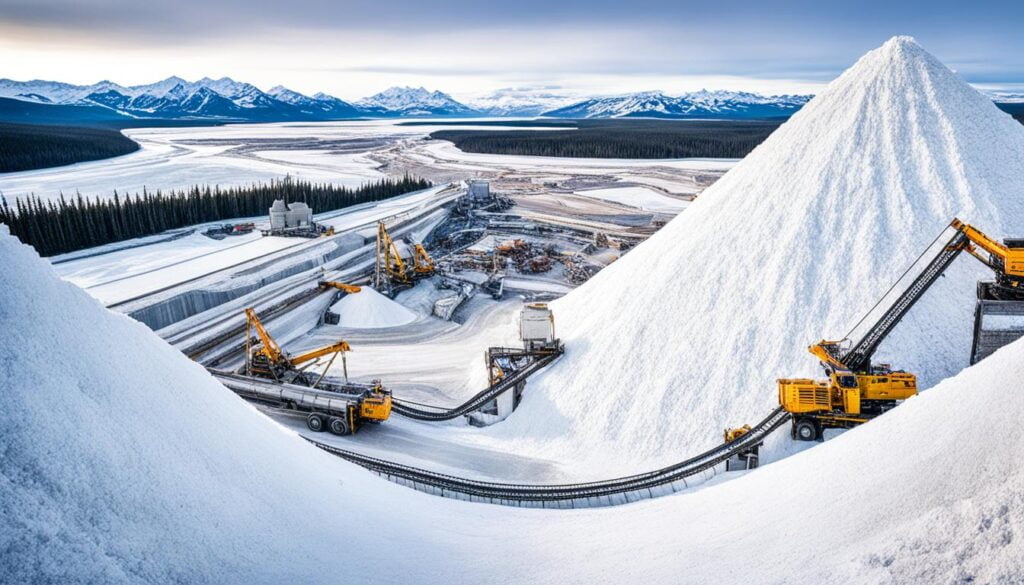
Thanks to its vast salt deposits and good mining setup, Canada stays a top salt maker.2 Even though it’s the world’s 5th largest producer after China, the U.S., India, and Germany.2 It’s still key in meeting the growing salt needs worldwide.1
Australia: A Significant Player in the Salt Industry
Australia is a key player in the world’s salt production, making about 13 million metric tons of salt a year.2 It uses many ways to make salt, taking full advantage of its climate and location to produce more.
Salt Production Methods in Australia
In Australia, one major way it makes salt is by letting seawater evaporate in the sun.9 The country’s sunny and dry weather is perfect for this. This method lets them get salt from the evaporated water. Australia also has a lot of salt in rocks, which are mined when needed.9 Another way is by getting saltwater from underground, then letting it evaporate, known as brine extraction.
Australia has many different places where salt is made. For instance, Western Australia makes the most salt in the country, with about 8 million tonnes each year.9 South Australia, though, had about 870,000 tonnes in 2013.9 There’s also Dry Creek, which made 391,000 tonnes in 1999.9 And the Price salt operation produced 88,000 tonnes in 1999, mainly for industrial and home use.9
Because of its perfect location, plenty of resources, and good infrastructure, Australia does very well in the salt industry.2 It uses its different salt making methods to be a big part of the world’s salt supply.
The Largest Salt Producers in the World
China, the United States, India, Germany, Canada, and Australia are leading salt producers globally. They make up over half of the world’s salt, as per the British Geological Survey and the USGS.21 China stands out, producing about 64 million metric tons each year, the most. The United States and India follow, making 42 million and 30 million metric tons, respectively.2
Top Countries by Salt Production Volume
China leads the world in salt production, making 68,517,465 tons each year. This is about 22.48% of the global production.1 The United States is next, producing 44,312,914 tons yearly, making up 14.54% of the total. India comes in third, making 27,006,626 tons annually.1
Collective Contribution to Global Salt Supply
Germany is fourth in salt production, contributing 19,021,295 tons a year. This is about 6.88% of the global supply.1 Canada ranks fifth, making 10,844,624 tons yearly, which is 3.92% of the global production.1 Australia is also important, producing 13 million metric tons annually.2
Data from the BGS and the USGS sheds light on the global salt production scene. They show us the key producers and how they meet the world’s salt needs. Collectively, these nations supply most of the salt needed worldwide.21
Factors Affecting Salt Production Globally
The amount of natural salt found in an area affects how much salt a country can make. Places with a lot of salt in the ground have a big head start in salt production.4 Being near the sea and having dry, sunny weather helps too. This kind of weather lets salt makers use the sun to dry and make salt.10
Geographic Salt Deposits
In some places, you can find a lot of salt in the ground. The quality and amount of this salt helps decide how much salt a country can produce.4 Countries with lots of good salt, like rock salt or brine, have a good chance to make a lot of salt. They can build big, effective salt-making places.
Coastal Access and Climate
If a country is close to the sea and has sunny, dry weather, it can produce a lot of salt.10 Using the sun to dry saltwater is common in these areas. This makes salt production more efficient.
Labor Force and Infrastructure
A skilled group of workers and good ways to mine, make, and move salt are very important.4 Countries with strong ways to build and use technology can make a lot of salt. They do this by working smart and using what they have well.
Salt Production Trends and Outlook
The world is using more salt, thanks to its many uses in industries like food, water treatment, and making chemicals.11 Because more salt is needed, countries are finding better ways to make it. They are using new technologies to make salt production more efficient and better for the environment.
Increasing Demand for Salt
As of 2023, the world sold salt worth USD 34.07 billion. This number is expected to reach USD 54.02 billion by 2032, growing at a rate of 5.3% each year.11 The chemical industry uses the most salt in its products, like caustic soda and chlorine.11 The Industrial Salt market will grow a lot because it’s needed in areas like chemical processing, de-icing, and for oil and water treatment.12
Technological Advancements in Salt Production
Countries are upgrading their ways of making salt to meet the growing demand. They’re using new technologies to mine salt, getting salt from brine more efficiently, and using better methods to evaporate water from salt.11 Rock salt was a top choice in 2023 because it’s used in de-icing, making chemicals, and more. It’s likely to keep being popular until 2032.11 In 2023, salt from mines was preferred due to its easy access underground. This kind of salt comes after different steps of mining and refining.11 The part of the market related to chemical processes is also big because salt is crucial in making certain chemicals.11
Countries are making salt production more advanced to keep up with the demand. They’re using new methods to mine salt, take brine out of the ground, and evaporate water to get salt. These steps can help make more salt.11
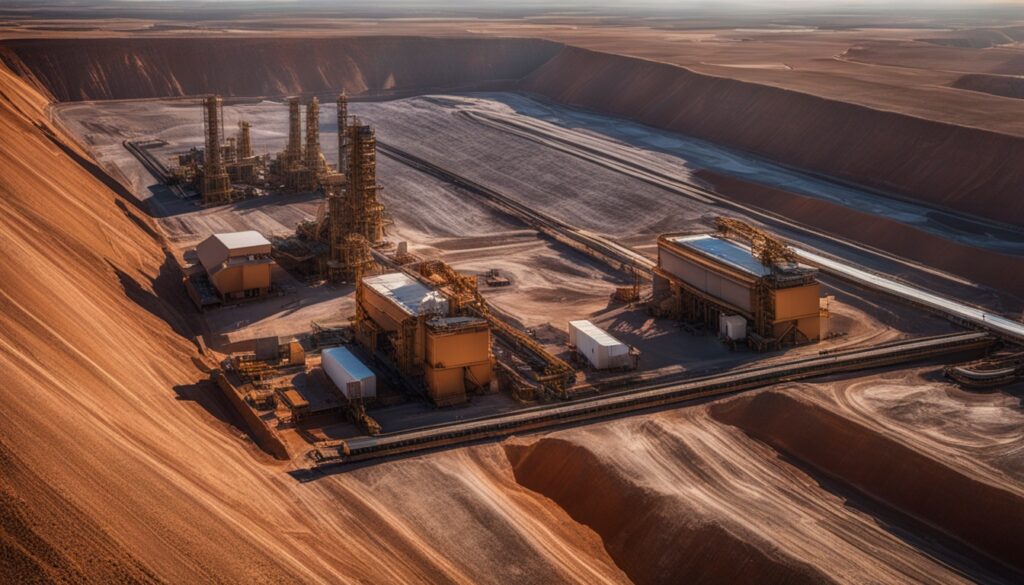
Environmental Considerations in Salt Production
The salt industry is growing worldwide. With this growth, comes the need to focus on sustainable practices to reduce harm to the environment.10 Urmia Saline Lake, a UNESCO-recognized site, has seen increased salt harvesting. This is due to its high salt content and severe dryness, causing private companies to intensify their salt collecting.10 These activities can cause harm. They may lead to damage of the environment and ecosystems around these lakes.10
Sustainable Salt Mining Practices
Countries are now taking steps to protect their surroundings. They do this by managing waste responsibly, restoring salt marshes, and using clean energy in salt production.10 To understand and lessen the harm of mining projects, many now use matrices in Environmental Impact Assessments (EIAs).10 For example, a study in Kenya’s Magarini District found that salt mining led to several environmental problems. These included corrosion, salinization, and deforestation.10
Impact on Local Ecosystems
In Namibia, the Cape Cross Salt Pan was studied before building a new salt production facility. Potential bad effects were rated as not too severe, but there were worries like habitat loss and lower water levels in the area.10 Urmia Saline Lake in Iran is very big, holding around eight billion tons of salt and other minerals. It is not just a big source of salt but also of magnesium, lithium, and potassium.10 However, the environmental studies there weren’t very detailed until recently, when concerns were raised about the effects of salt extraction.10
Working to address these issues, the salt industry can better protect the environment and its resources over time.
Economic Significance of the Salt Industry
The salt industry impacts global and local economies. It is traded worldwide by major players. Since 2800 BCE, when the Egyptians traded salted fish, it has been a key trade item. This trade has influenced the growth of empires, with many powers looking to control salt production.
For instance, Britain expanded its territories to gain access to salt-rich areas. In the 17th century, it harvested salt from the Caribbean. Such moves aimed to strengthen these empires economically.13
Salt Trade and Global Markets
Salts’ global reach contributes to the economy and job market, especially in regions with high salt production. However, when colonies faced control over salt by empires, they often sought independence. This led to conflicts over who controlled the salt supplies.13
Because of its scarcity in certain areas, the salt trade has always been profitable. This has fueled a rich history of salt trading around the world.
Job Creation and Economic Development
The salt industry benefits more than just salt producers. It’s a vital component for other industries, boosting overall economic growth. In the U.S., for example, the industry’s total value was estimated at $2.3 billion in 2019.
Production in the U.S. had gone up to 42 million tons that year. Seven states, mainly Kansas, Louisiana, and New York, produced most of this salt. This growth in production also maintained stable employment in the industry, with about 4,100 workers in mines and plants.14
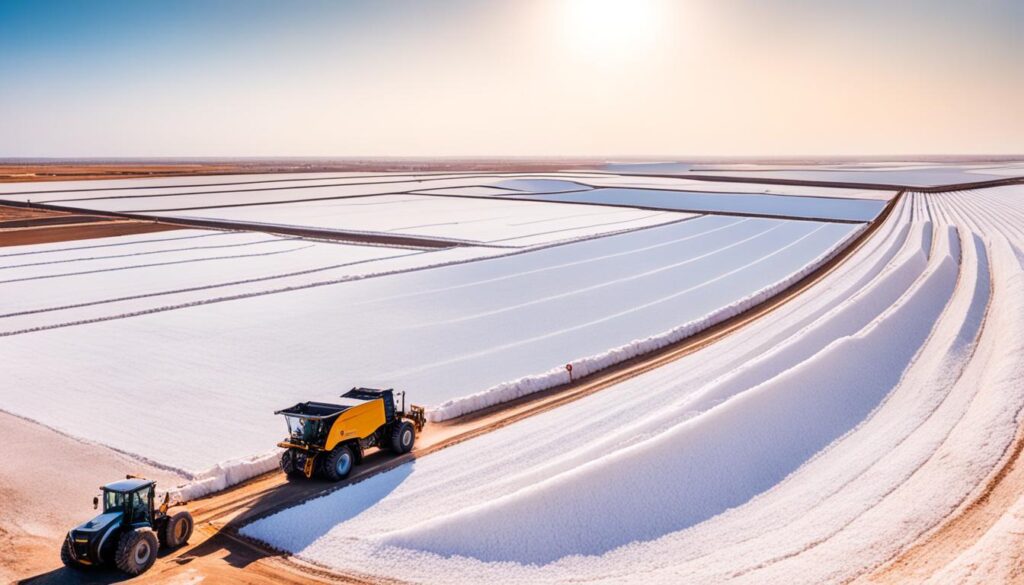
Conclusion
Salt is very important for many industries around the world. The global salt production industry is run by a few major players, including China, the United States, and India. They are the top producers. These countries, plus Germany, Canada, and Australia, make more than half of the world’s salt supply.15
The amount of salt each country can produce is influenced by many things. These include where the salt deposits are, how close they are to the coast, the climate, and the local infrastructure. With the growing need for salt, the industry is looking to use more sustainable ways to meet the demand without harming the environment.16
The economic significance of the salt industry is big. It impacts global trade, creates jobs, and helps local economies grow. Salt producers, sea salt producers, and the largest salt companies in the world are key in providing this vital commodity. They help various industries grow and develop.16
FAQ
What are the six leading salt producers in the world?
China, the United States, India, Germany, Canada, and Australia are the top six. They make more than half of the world’s salt.
How much salt does China produce annually?
China makes about 64 million metric tons of salt every year. It’s the leading producer in the world.
How much salt does the United States produce annually?
The United States comes next, producing around 42 million metric tons yearly.
How much salt does India produce annually?
India is third, making over 30 million metric tons of salt each year.
How much salt does Germany produce annually?
Germany, a top producer in Europe, makes about 15 million metric tons annually.
How much salt does Canada produce annually?
Canada produces about 11 million metric tons of salt yearly.
How much salt does Australia produce annually?
Australia produces around 13 million metric tons of salt annually.
What factors influence global salt production?
The amount of natural salt, access to seawater, climate, and skilled workers matter. These help countries produce a lot of salt.
What are the main salt production techniques used globally?
People use solar evaporation, brine extraction, and mining for salt production.
How is the global demand for salt changing?
Demand for salt is going up. It’s used a lot in food, water, and making chemicals. This keeps the demand high.
Source Links
- https://www.worldatlas.com/articles/the-world-s-top-salt-producing-countries.html
- https://en.wikipedia.org/wiki/List_of_countries_by_salt_production
- https://seasalt.com/history-of-salt
- https://worldpopulationreview.com/country-rankings/salt-production-by-country
- https://en.wikipedia.org/wiki/Great_Salt_Lake
- https://www.ncbi.nlm.nih.gov/pmc/articles/PMC3543363/
- https://india.mongabay.com/2024/03/uncertain-weather-makes-that-pinch-of-salt-dearer/
- https://www.ibisworld.com/germany/industry/salt-extraction/710/
- https://www.energymining.sa.gov.au/industry/minerals-and-mining/mineral-commodities/salt
- https://www.ncbi.nlm.nih.gov/pmc/articles/PMC8172734/
- https://www.fortunebusinessinsights.com/salt-market-103011
- https://www.linkedin.com/pulse/industrial-salt-market-size-2023-share-trends
- https://www.shortform.com/blog/importance-of-salt-in-history/
- https://pubs.usgs.gov/periodicals/mcs2020/mcs2020-salt.pdf
- https://worldunfolds.com/largest-producer-of-salt-in-the-world/
- https://selectsalt.com/salt-cave-business/the-modern-salt-industry-a-comprehensive-overview

